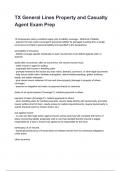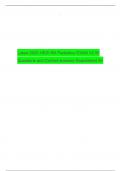Exam (elaborations)
TX General Lines Property and Casualty Agent Exam Prep QUESTIONS AND CORRECT DETAILED ANSWERS |ALREADY GRADED A+
- Course
- Institution
TX General Lines Property and Casualty Agent Exam Prep QUESTIONS AND CORRECT DETAILED ANSWERS |ALREADY GRADED A+
[Show more]




